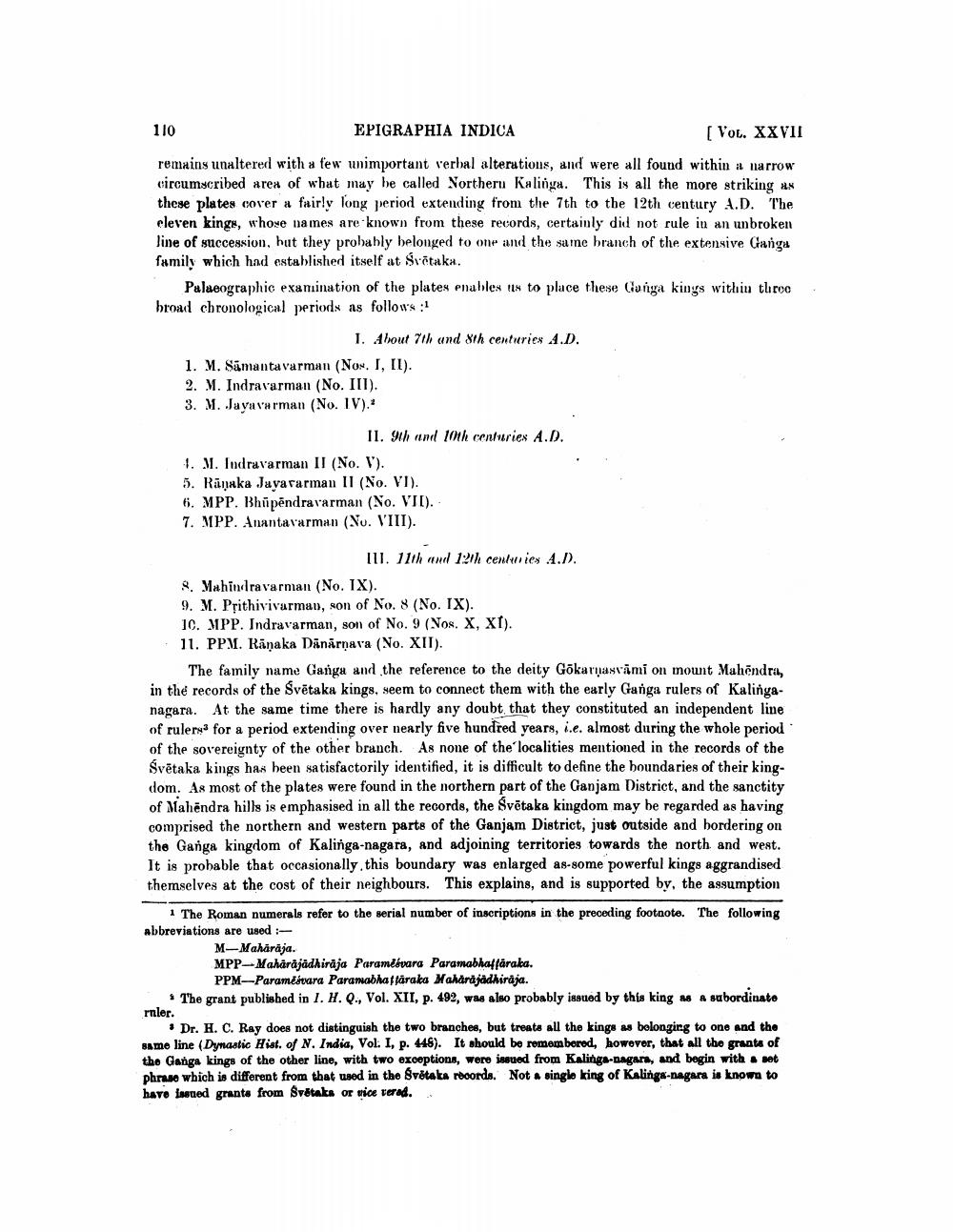________________
110
EPIGRAPHIA INDICA
[Vol. XXVII remains unaltered with a few unimportant verbal alterations, and were all found within a narrow circumscribed area of what may be called Northeru Kalinga. This is all the more striking as these plates cover a fairly long period extending from the 7th to the 12th century A.D. "The cleven kings, whose names are known from these records, certainly did not rule in an unbroken Jine of succession, hut they probably belonged to one and the same branch of the extensive Ganga family which had established itself at Svētaka.
Palaeographic examination of the plates enables its to place these Conga kinys within three broad chronological periods as follows:1
1. About 7th and 8th centuries 4.D. 1. M. Sämantavarman (Nox. I, II). 2. M. Indravarman (No. III). 3. M. Ja va loa rman (No. 1V).
II. 9th and 10th centuries A.D. 1. M. lodravarman II (No. V). 5. Rāraka Jayararman II (No. VI). 6. MPP. Bhūpēndravarman (No. VII). 7. MPP. Anantavarman (No. VIII).
IU. 11th and 12th centuies 4.D. & Mahindravarman (No. IX). 9. M. Prithivivarman, son of No. 8 (No. IX). 10. MPP. Indravarman, son of No. 9 (Nos. X, XI). 11. PPM. Ränaka Dānārnava (No. XI).
The family name Ganga and the reference to the deity Gökarnasvāmi on mount Mahēndra, in the records of the Svētaka kings, seem to connect them with the early Ganga rulers of Kalinganagara. At the same time there is hardly any doubt that they constituted an independent line of rulere for a period extending over nearly five hundred years, i.e. almost during the whole period of the sovereignty of the other branch. As none of the localities mentioned in the records of the Svētaka kings has been satisfactorily identified, it is difficult to define the boundaries of their kingdom. As most of the plates were found in the northern part of the Ganjam District, and the sanctity of Mahendra hills is emphasised in all the records, the Svētaka kingdom may be regarded as having comprised the northern and western parts of the Ganjam District, just outside and bordering on the Ganga kingdom of Kalinga-nagara, and adjoining territories towards the north and west. It is probable that occasionally, this boundary was enlarged as-some powerful kings aggrandised themselves at the cost of their neighbours. This explains, and is supported by, the assumption
1 The Roman numerals refer to the serial number of inscriptions in the preceding footnote. The following abbreviations are used :
M-Mahārāja. MPP-Maharajadhiraja Parameswara Paramabhaffaraka.
PPM-Parameswara Paramabhaffäraka Maharajadhiraja. * The grant published in 1. H.Q., Vol. XII, p. 492, was also probably issued by this king as a subordinate rnler.
• Dr. H. C. Ray does not distinguish the two branches, but treats all the kings as belonging to one and the same line (Dynastic Hist. of N. India, Vol. I, p. 446). It should be remembered, however, that all the granta of the Ganga kings of the other line, with two exceptions, were issued from Kalinga-nagar, and begin with a set phrase which is different from that used in the Svetats records. Not a single king of Kalinga-negara is known to havo lasued grants from Svetats or vice vered..




